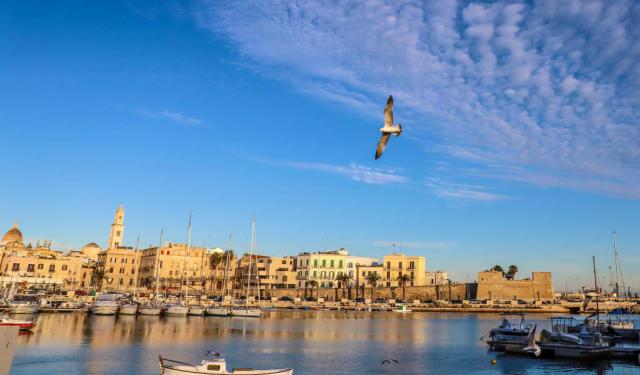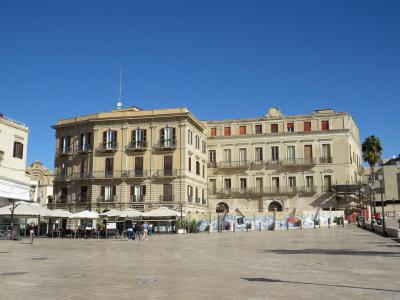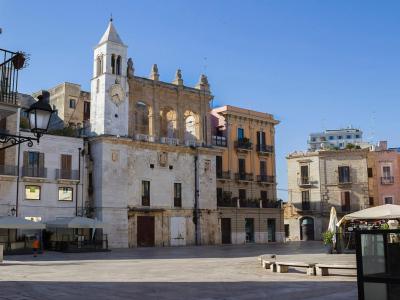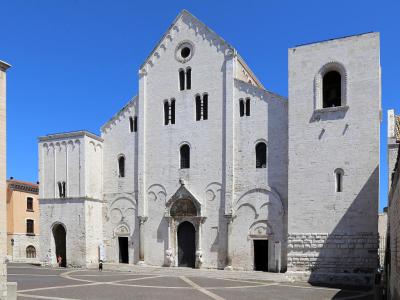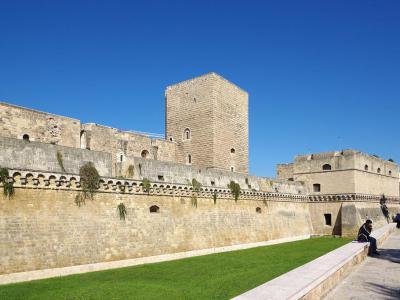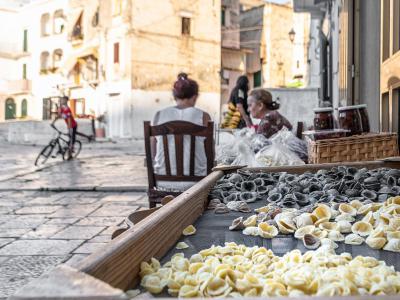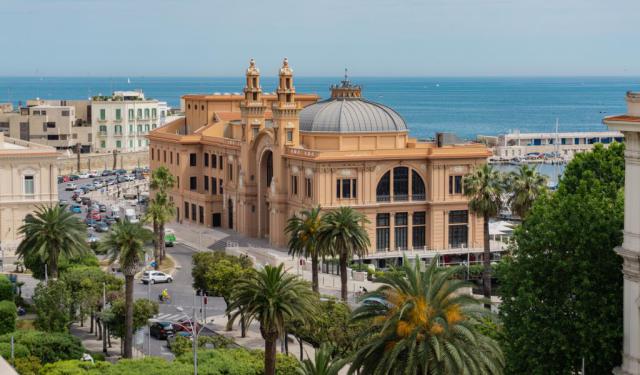Audio Guide: Bari Introduction Walking Tour (Self Guided), Bari
American novelist Jeffery Deaver usually spins tales of murder and intrigue, yet even he paused in Bari long enough to swap suspense for admiration, calling it the “gem of Italy’s Adriatic coast.”
Gems, of course, take time to form-and Bari’s sparkle was earned over millennia. Its earliest name, Barion, is thought to derive from Illyrian roots, describing a settlement by the sea. By the 4th century BC, Greek influence had reached the Adriatic, and soon after, the Romans recognized Bari’s strategic position. In the 3rd century BC, it was formally colonized, and in 59 BC it became a Roman municipality under Julius Caesar. From then on, Roman influence shaped its layout with a grid of streets, aqueducts, and a thriving harbor that linked inland Apulia with Mediterranean trade routes.
After the fall of the Western Roman Empire, Bari came under Byzantine control and became the capital of the Byzantine province of Apulia and Calabria. Its role as a frontier city made it a frequent target-attacked by Lombards, Saracens, and later the Normans. The Arab conquest of 847 created an emirate that lasted until 871, when Carolingian Emperor Louis II reclaimed it for Christendom. The Byzantines later reestablished their authority, but the city remained a crossroads of shifting powers.
A defining moment came in 1087, when sailors brought the relics of Saint Nicholas from Myra in modern-day Turkey to Bari. This act transformed the city into a major pilgrimage destination. The grand Basilica of Saint Nicholas soon rose above the Old Town and, alongside Bari Cathedral, became a beacon for both Catholic and Orthodox Christians. Around the same time, Norman forces gained control, and their legacy survives in the imposing Swabian Castle, later rebuilt by Emperor Frederick II in the 13th century. The castle served as both fortress and royal residence, hosting important figures such as St. Francis of Assisi, the founder of the Franciscan order.
Through the centuries, Bari passed under the rule of Venetian traders, Angevin kings, Spanish monarchs, and finally the Habsburgs. Despite political upheavals, its harbor ensured steady prosperity, keeping the city tied to Mediterranean commerce. Thankfully, the narrow alleys of Old Bari preserved landmarks such as the Basilica of Saint Nicholas and Bari Cathedral, while the Swabian Castle stands as a reminder of the city’s medieval strength. At the other end of the spectrum, Merchant Square and Ferrarese Square buzz with cafés and chatter. The squares branch out into Vittorio Emanuele II Lane and the seaside promenade, where the vibrancy of city life meets the calm of the sea.
Today, Bari still gleams on the Adriatic, living up to Deaver’s acclaim. It remains a gem-its shine not diminished by centuries of power struggles, but polished by them.
Gems, of course, take time to form-and Bari’s sparkle was earned over millennia. Its earliest name, Barion, is thought to derive from Illyrian roots, describing a settlement by the sea. By the 4th century BC, Greek influence had reached the Adriatic, and soon after, the Romans recognized Bari’s strategic position. In the 3rd century BC, it was formally colonized, and in 59 BC it became a Roman municipality under Julius Caesar. From then on, Roman influence shaped its layout with a grid of streets, aqueducts, and a thriving harbor that linked inland Apulia with Mediterranean trade routes.
After the fall of the Western Roman Empire, Bari came under Byzantine control and became the capital of the Byzantine province of Apulia and Calabria. Its role as a frontier city made it a frequent target-attacked by Lombards, Saracens, and later the Normans. The Arab conquest of 847 created an emirate that lasted until 871, when Carolingian Emperor Louis II reclaimed it for Christendom. The Byzantines later reestablished their authority, but the city remained a crossroads of shifting powers.
A defining moment came in 1087, when sailors brought the relics of Saint Nicholas from Myra in modern-day Turkey to Bari. This act transformed the city into a major pilgrimage destination. The grand Basilica of Saint Nicholas soon rose above the Old Town and, alongside Bari Cathedral, became a beacon for both Catholic and Orthodox Christians. Around the same time, Norman forces gained control, and their legacy survives in the imposing Swabian Castle, later rebuilt by Emperor Frederick II in the 13th century. The castle served as both fortress and royal residence, hosting important figures such as St. Francis of Assisi, the founder of the Franciscan order.
Through the centuries, Bari passed under the rule of Venetian traders, Angevin kings, Spanish monarchs, and finally the Habsburgs. Despite political upheavals, its harbor ensured steady prosperity, keeping the city tied to Mediterranean commerce. Thankfully, the narrow alleys of Old Bari preserved landmarks such as the Basilica of Saint Nicholas and Bari Cathedral, while the Swabian Castle stands as a reminder of the city’s medieval strength. At the other end of the spectrum, Merchant Square and Ferrarese Square buzz with cafés and chatter. The squares branch out into Vittorio Emanuele II Lane and the seaside promenade, where the vibrancy of city life meets the calm of the sea.
Today, Bari still gleams on the Adriatic, living up to Deaver’s acclaim. It remains a gem-its shine not diminished by centuries of power struggles, but polished by them.
How it works: Download the app "GPSmyCity: Walks in 1K+ Cities" from Apple App Store or Google Play Store to your mobile phone or tablet. The app turns your mobile device into a personal tour guide and its built-in GPS navigation functions guide you from one tour stop to next. The app works offline, so no data plan is needed when traveling abroad.
Bari Introduction Walking Tour Map
Guide Name: Bari Introduction Walking Tour
Guide Location: Italy » Bari (See other walking tours in Bari)
Guide Type: Self-guided Walking Tour (Sightseeing)
# of Attractions: 8
Tour Duration: 1 Hour(s)
Travel Distance: 2.2 Km or 1.4 Miles
Author: DanaOffice
Sight(s) Featured in This Guide:
Guide Location: Italy » Bari (See other walking tours in Bari)
Guide Type: Self-guided Walking Tour (Sightseeing)
# of Attractions: 8
Tour Duration: 1 Hour(s)
Travel Distance: 2.2 Km or 1.4 Miles
Author: DanaOffice
Sight(s) Featured in This Guide:
- Piazza del Ferrarese (Ferrarese Square)
- Piazza Mercantile (Merchant Square)
- Basilica San Nicola (Basilica of Saint Nicholas)
- Cattedrale di San Sabino (Bari Cathedral)
- Castello Normanno-Svevo (Swabian Castle)
- Strada delle Orecchiette ("Ears" Pasta Street)
- Corso Vittorio Emanuele II (Vittorio Emanuele II Lane)
- Lungomare e Murat (Bari Promenade)
1) Piazza del Ferrarese (Ferrarese Square)
Ferrarese Square, opened in 1612, has always been more than just an open space in Bari-it is where the city’s commercial, spiritual, and social rhythms meet. It owes its name to Stefano Fabri, a 17th-century merchant from Ferrara whose trade house anchored the square and linked it closely to the port. From the beginning, it was conceived as an extension of the Merchant Square, helping to handle the flow of goods and people arriving from the Adriatic. Its position, right at the edge of the old city walls, made it a natural threshold between medieval Bari and the expanding neighborhoods that grew outside the fortifications.
The square’s layered history is still visible today. Parts of the Roman Trajan's Appian Way, the road that once tied Rome to the Adriatic, were uncovered during recent renovations. Baroque facades, 19th-century buildings, and the Vallisa Church apse stand nearby, while the Starita Palace, built over an old arsenal, reminds visitors of Bari’s centuries as a seafaring hub. Over time, Ferrarese Square became the backdrop for markets and gatherings, and it still carries that energy forward, now filled with cafés, restaurants, and the hum of nightlife.
The square also plays a central role in Bari’s devotion to Saint Nicholas. Each May, during the saint’s feast, pilgrims crowd into the square as the statue of the beloved patron arrives by boat, greeted with fireworks over the Adriatic. For many, this moment blends faith with celebration, turning the square into a stage for both devotion and joy.
Today, to linger in Ferrarese Square is to feel Bari’s past and present in one glance: Roman stones underfoot, Venetian and Baroque walls around, and locals chatting over espresso as music and festivals animate the air. It is the kind of place where the city’s story is not just remembered-it is lived.
The square’s layered history is still visible today. Parts of the Roman Trajan's Appian Way, the road that once tied Rome to the Adriatic, were uncovered during recent renovations. Baroque facades, 19th-century buildings, and the Vallisa Church apse stand nearby, while the Starita Palace, built over an old arsenal, reminds visitors of Bari’s centuries as a seafaring hub. Over time, Ferrarese Square became the backdrop for markets and gatherings, and it still carries that energy forward, now filled with cafés, restaurants, and the hum of nightlife.
The square also plays a central role in Bari’s devotion to Saint Nicholas. Each May, during the saint’s feast, pilgrims crowd into the square as the statue of the beloved patron arrives by boat, greeted with fireworks over the Adriatic. For many, this moment blends faith with celebration, turning the square into a stage for both devotion and joy.
Today, to linger in Ferrarese Square is to feel Bari’s past and present in one glance: Roman stones underfoot, Venetian and Baroque walls around, and locals chatting over espresso as music and festivals animate the air. It is the kind of place where the city’s story is not just remembered-it is lived.
2) Piazza Mercantile (Merchant Square)
Merchant Square has been the stage for Bari’s public life for centuries, a place where power, trade, and daily routine came together in full view of the Adriatic. Established in the 13th century at the edge of the Old Town, it quickly grew into the city’s commercial heart. Merchants set up stalls, officials read out proclamations, and townspeople crowded the space to hear news or celebrate feast days. It was also the starting point of the Francigena street, the medieval pilgrims’ route leading to the Cathedral of Saint Nicholas, tying the square to both faith and commerce. Linked to the port by the fortified Tower of Sant’Antonio, the square was a gateway for traders and travelers alike.
The square also carried a darker side of justice. For centuries, the Pillar of Justice stood in plain sight, where bankrupt debtors were chained as a warning to others. This ritual of shame left an indelible mark on the memory of the place, a reminder that commerce in Bari was not only opportunity but also risk. Over time, the square took on layers of meaning-Palazzo del Sedile housed the city council, while its clock tower marked the hours of both labor and leisure.
Even catastrophe could not silence the square. After the fire and explosions of 1601, the ruling House of Sforza oversaw a renewal that gave Merchant Square new life, linking it directly to Ferrarese Square and reinforcing its role as the city’s business center.
The square no longer chains debtors, but it still chains people’s attention. Cafés and restaurants spill out onto the stones, and journalist Lino Patruno once compared it to a model that never stops winning hearts, “as if it were for the first time.” For visitors, Merchant Square remains what it always was: the beating civic and social heart of Bari.
The square also carried a darker side of justice. For centuries, the Pillar of Justice stood in plain sight, where bankrupt debtors were chained as a warning to others. This ritual of shame left an indelible mark on the memory of the place, a reminder that commerce in Bari was not only opportunity but also risk. Over time, the square took on layers of meaning-Palazzo del Sedile housed the city council, while its clock tower marked the hours of both labor and leisure.
Even catastrophe could not silence the square. After the fire and explosions of 1601, the ruling House of Sforza oversaw a renewal that gave Merchant Square new life, linking it directly to Ferrarese Square and reinforcing its role as the city’s business center.
The square no longer chains debtors, but it still chains people’s attention. Cafés and restaurants spill out onto the stones, and journalist Lino Patruno once compared it to a model that never stops winning hearts, “as if it were for the first time.” For visitors, Merchant Square remains what it always was: the beating civic and social heart of Bari.
3) Basilica San Nicola (Basilica of Saint Nicholas) (must see)
The Basilica of Saint Nicholas in Bari is more than a landmark; it is the story of how a city was transformed by faith, devotion, and legend. The tale begins in 1087, when sailors from Bari set sail for Myra, in present-day Turkey, and returned with the relics of Saint Nicholas, the miracle-working bishop whose reputation had spread across Christendom. Bringing his bones back to Bari was not just a daring act-it was a turning point that placed the city firmly on the map of Europe as a place of pilgrimage. Almost immediately, construction began on a church worthy of the saint, rising over the remains of the old Byzantine governor’s palace.
The man at the heart of all this, Nicholas himself, was born in the 3rd century. Known for his generosity and miracles, he became Bishop of Myra and endured persecution under Diocletian before his reputation as a protector of sailors, children, and the vulnerable took root. When Bari’s merchants brought his relics to Italy, they were greeted with both celebration and awe, and by 1197 the basilica was consecrated in the presence of Emperor Henry VI. From that moment, the city was not only a vital port but also a spiritual destination, visited by both Catholics and Orthodox pilgrims-a rare point of unity in a divided medieval world.
One of Bari’s most enduring traditions still recalls the sailors’ voyage: every May, during the Feast of Saint Nicholas, the saint’s statue is carried through the streets and taken out to sea before returning in a grand procession. The event blends faith and folklore, filling the city with music, fireworks, and prayers, and it remains one of Bari’s proudest celebrations.
Inside the basilica today, visitors find not just frescoes and stone columns but a crypt where pilgrims kneel at the saint’s marble tomb, often alongside curious travelers. Here, history and devotion mingle in a way that feels timeless. For Bari, the basilica was never only about architecture-it was about becoming more than a port, a city anchored in the enduring presence of its patron saint.
The man at the heart of all this, Nicholas himself, was born in the 3rd century. Known for his generosity and miracles, he became Bishop of Myra and endured persecution under Diocletian before his reputation as a protector of sailors, children, and the vulnerable took root. When Bari’s merchants brought his relics to Italy, they were greeted with both celebration and awe, and by 1197 the basilica was consecrated in the presence of Emperor Henry VI. From that moment, the city was not only a vital port but also a spiritual destination, visited by both Catholics and Orthodox pilgrims-a rare point of unity in a divided medieval world.
One of Bari’s most enduring traditions still recalls the sailors’ voyage: every May, during the Feast of Saint Nicholas, the saint’s statue is carried through the streets and taken out to sea before returning in a grand procession. The event blends faith and folklore, filling the city with music, fireworks, and prayers, and it remains one of Bari’s proudest celebrations.
Inside the basilica today, visitors find not just frescoes and stone columns but a crypt where pilgrims kneel at the saint’s marble tomb, often alongside curious travelers. Here, history and devotion mingle in a way that feels timeless. For Bari, the basilica was never only about architecture-it was about becoming more than a port, a city anchored in the enduring presence of its patron saint.
4) Cattedrale di San Sabino (Bari Cathedral) (must see)
Bari Cathedral, formally dedicated to Saint Sabinus, carries the scars and resilience of a city that has been rebuilt more than once. Its story begins in the 6th century, when a basilica first rose on the site, tied to the memory of Bishop Sabinus of Canosa. That early church, however, would not survive the fury of King William I of Sicily-known as “Il Malo,” or “the Wicked.” In 1156, he stormed Bari and razed most of the city, sparing only the Basilica of Saint Nicholas. The cathedral was left in ruins, a victim of conquest and power struggles that defined southern Italy in the Middle Ages.
From that devastation, Bari slowly reclaimed its spirit. Over the following decades, a new cathedral was built in the Apulian Romanesque style, solid and restrained, a clear sign of determination rather than excess. When it was finally consecrated in 1292, the people of Bari had not only rebuilt their place of worship but also reaffirmed their faith and identity. Within its crypt, the relics of Saint Sabinus found a permanent home, making the cathedral an enduring focal point for local devotion. Pilgrims still come to pay respects, their prayers mingling with centuries of whispered hopes that have filled the space since the relics arrived in 844.
Through time, the cathedral bore the marks of change-frescoes added, baroque details layered, bomb damage during World War II repaired-but the core remained the same: a space where daily life unfolded. Baptisms, weddings, funerals, and festivals tied the community to its cathedral in ways that survived wars and rulers alike.
From the relics in the crypt to the steady presence of worshippers, Bari Cathedral embodies endurance. It reminds visitors that cities, like faith, can be shaken but still rise again.
From that devastation, Bari slowly reclaimed its spirit. Over the following decades, a new cathedral was built in the Apulian Romanesque style, solid and restrained, a clear sign of determination rather than excess. When it was finally consecrated in 1292, the people of Bari had not only rebuilt their place of worship but also reaffirmed their faith and identity. Within its crypt, the relics of Saint Sabinus found a permanent home, making the cathedral an enduring focal point for local devotion. Pilgrims still come to pay respects, their prayers mingling with centuries of whispered hopes that have filled the space since the relics arrived in 844.
Through time, the cathedral bore the marks of change-frescoes added, baroque details layered, bomb damage during World War II repaired-but the core remained the same: a space where daily life unfolded. Baptisms, weddings, funerals, and festivals tied the community to its cathedral in ways that survived wars and rulers alike.
From the relics in the crypt to the steady presence of worshippers, Bari Cathedral embodies endurance. It reminds visitors that cities, like faith, can be shaken but still rise again.
5) Castello Normanno-Svevo (Swabian Castle) (must see)
The Swabian Castle of Bari, sometimes called the Hohenstaufen Castle, has stood in one form or another for nearly nine centuries, its stones carrying the weight of both destruction and rebirth. Its origins go back to around 1132, when the Norman king Roger II ordered its construction to secure Bari’s harbor and surrounding lands. But in 1156, William I of Sicily-nicknamed “the Wicked”-swept through the city, razing much of it to the ground, including the fortress. What could have been its end became instead a turning point, for in 1233 Emperor Frederick II rebuilt the castle on a grander scale, transforming it into one of the strongest symbols of his reign in southern Italy.
The fortress was more than a military outpost. It doubled as a royal residence, a place where rulers held court and where alliances were forged. One of its most famous anecdotes comes from 1221, when St. Francis of Assisi is said to have stayed here as Frederick’s guest. According to legend, the emperor-skeptical of Francis’s holiness-sent a courtesan to tempt him. But when she approached his bed, she saw it engulfed in flames and fled in terror. Frederick, secretly watching, was so struck by what he saw that he never doubted Francis again. The story, half miracle and half morality play, still lingers in the castle’s lore.
Over the centuries, the castle passed through many hands-the Angevins, the Aragonese, and later rulers of Spain and Naples-all of whom modified it to suit their purposes. Its moat and towers reflect a history of defense, while its courtyards and hallways recall a time of ceremony and rule.
Nowadays, the Swabian Castle no longer bristles with cannons, but it remains a cornerstone of Bari’s identity. Visitors wander through its courtyards, exhibitions, and echoing halls, while its towers still command views toward the Adriatic. To walk here is to step into layers of history-Norman ambition, Frederick’s authority, Francis’s legend-all fused into one enduring monument. It is not only stone and battlements, but a living reminder of Bari’s resilience and place on the frontier between empires.
The fortress was more than a military outpost. It doubled as a royal residence, a place where rulers held court and where alliances were forged. One of its most famous anecdotes comes from 1221, when St. Francis of Assisi is said to have stayed here as Frederick’s guest. According to legend, the emperor-skeptical of Francis’s holiness-sent a courtesan to tempt him. But when she approached his bed, she saw it engulfed in flames and fled in terror. Frederick, secretly watching, was so struck by what he saw that he never doubted Francis again. The story, half miracle and half morality play, still lingers in the castle’s lore.
Over the centuries, the castle passed through many hands-the Angevins, the Aragonese, and later rulers of Spain and Naples-all of whom modified it to suit their purposes. Its moat and towers reflect a history of defense, while its courtyards and hallways recall a time of ceremony and rule.
Nowadays, the Swabian Castle no longer bristles with cannons, but it remains a cornerstone of Bari’s identity. Visitors wander through its courtyards, exhibitions, and echoing halls, while its towers still command views toward the Adriatic. To walk here is to step into layers of history-Norman ambition, Frederick’s authority, Francis’s legend-all fused into one enduring monument. It is not only stone and battlements, but a living reminder of Bari’s resilience and place on the frontier between empires.
6) Strada delle Orecchiette ("Ears" Pasta Street)
They say that to truly know Bari, you must pass through the Low Arch and find yourself on the Street of the “Little Ears.” This narrow stretch of Old Bari, hidden among twisting lanes, carries a timeless atmosphere where everyday life and tradition unfold openly before visitors’ eyes. Here, the “orecchiette” pasta-so named for its little ear shape-has been made for generations by women who set up wooden tables right outside their doorways. With nimble thumbs, they press and flick the dough into shape, chatting with neighbors, keeping an eye on children, and occasionally selling bags of fresh pasta to passersby. It is not performance, but routine, a tradition woven into family life that has endured for centuries.
The street’s location near the Basilica of Saint Nicholas is telling. For pilgrims who once walked through these alleys, the sight of women working pasta became part of the city’s rhythm-faith, food, and community inseparable. One anecdote often shared is how grandmothers teach their granddaughters the thumb-rolling technique by having them practice on tiny lumps of dough, reminding them that “orecchiette must hold the sauce like a cradle.” In this way, skill and culture are passed down at the kitchen table as naturally as conversation.
Pasta Street is less about sightseeing and more about immersion. The earthy scent of semolina drifts through the air, knives clatter on wooden boards, and the warmth of neighborhood life surrounds you. Buying a bag of fresh orecchiette, or even sitting down for a home-cooked meal, offers not just food but a taste of Bari’s enduring spirit-simple, generous, and alive in its oldest streets.
The street’s location near the Basilica of Saint Nicholas is telling. For pilgrims who once walked through these alleys, the sight of women working pasta became part of the city’s rhythm-faith, food, and community inseparable. One anecdote often shared is how grandmothers teach their granddaughters the thumb-rolling technique by having them practice on tiny lumps of dough, reminding them that “orecchiette must hold the sauce like a cradle.” In this way, skill and culture are passed down at the kitchen table as naturally as conversation.
Pasta Street is less about sightseeing and more about immersion. The earthy scent of semolina drifts through the air, knives clatter on wooden boards, and the warmth of neighborhood life surrounds you. Buying a bag of fresh orecchiette, or even sitting down for a home-cooked meal, offers not just food but a taste of Bari’s enduring spirit-simple, generous, and alive in its oldest streets.
7) Corso Vittorio Emanuele II (Vittorio Emanuele II Lane)
Vittorio Emanuele II Lane may look like a typical boulevard at first glance, but it carries the imprint of Bari’s leap into modernity. In the 19th century, as Italy had just unified under King Vittorio Emanuele II, Bari was reshaping itself to match the ambitions of a new nation. The old town still kept its winding alleys and medieval pace, but this new street cut boldly through the Murat Quarter with straight lines and broad views. It was a declaration that Bari was ready to step beyond its ancient walls and claim its role as a modern capital of the Adriatic.
The street had even earlier roots, tied to a grand plan of Ferdinand II of the Two Sicilies, who dreamed of lining it with imposing public buildings. Only a few, like the Prefecture and Puccini Theatre, were ever realized, but after unification the road was renamed for the new king and took on a fresh purpose. Government offices, cafés, and shops filled its length, and it quickly became both a civic stage and a social promenade. Bari’s parades marched here, speeches echoed from its steps, and in the evenings locals made strolling the lane almost a ritual-pausing to chat beneath palms or in front of cafés.
By the 20th century, the addition of the Margaret Theatre at one end anchored the boulevard, turning it into a lively corridor between Garibaldi Square and the Adriatic. For visitors today, the lane is more than a busy street; it’s a walk through Bari’s 19th-century ambitions, where the pulse of a new Italy still beats beneath the rhythm of modern city life.
The street had even earlier roots, tied to a grand plan of Ferdinand II of the Two Sicilies, who dreamed of lining it with imposing public buildings. Only a few, like the Prefecture and Puccini Theatre, were ever realized, but after unification the road was renamed for the new king and took on a fresh purpose. Government offices, cafés, and shops filled its length, and it quickly became both a civic stage and a social promenade. Bari’s parades marched here, speeches echoed from its steps, and in the evenings locals made strolling the lane almost a ritual-pausing to chat beneath palms or in front of cafés.
By the 20th century, the addition of the Margaret Theatre at one end anchored the boulevard, turning it into a lively corridor between Garibaldi Square and the Adriatic. For visitors today, the lane is more than a busy street; it’s a walk through Bari’s 19th-century ambitions, where the pulse of a new Italy still beats beneath the rhythm of modern city life.
8) Lungomare e Murat (Bari Promenade) (must see)
The Bari Promenade stretches for kilometers along the Adriatic, curving like a ribbon between the sea and the city. Its origins lie in the 1920s and ’30s, when Bari was being reshaped under Fascist rule to look modern and monumental. The waterfront, once hemmed in by medieval walls, was opened up into a wide, sweeping promenade meant to show Bari’s role as both a regional capital and a city that embraced the sea. Even as politics and architecture changed, the Lungomare quickly became what locals fondly call their “front porch.”
Generations of Baresi have come here to walk, talk, and watch the horizon. Old photographs show Sunday promenades with families dressed in their best, while fishermen sat on the stone balustrades, swapping news of the day’s catch. One story often repeated is how young couples would sneak away from the crowded squares into the quieter stretches of the Promenade, finding a bench or a corner of sea wall to claim as their own, with the sunset as witness. Such rituals helped make the promenade not just a street but a stage for everyday life.
Along the way, landmarks rise into view: the medieval walls of Bari Vecchia, the Basilica of Saint Nicholas, Ferrarese and Merchant Squares, the Swabian Castle, and the more modern architecture of the Murat Quarter, itself the result of Napoleon’s brother-in-law, Joachim Murat, who ordered a new district built in the early 19th century. The promenade has framed all these layers for nearly a century, giving Bari one long walkway through its history.
The seafront still pulses with life. Cafés spill into the street, fishermen mend their nets in the sun, and at night the lamps curve like pearls along the seafront. For visitors, a stroll here is less about reaching a destination than about stepping into Bari’s rhythm, where sea and city have always belonged to one another.
Generations of Baresi have come here to walk, talk, and watch the horizon. Old photographs show Sunday promenades with families dressed in their best, while fishermen sat on the stone balustrades, swapping news of the day’s catch. One story often repeated is how young couples would sneak away from the crowded squares into the quieter stretches of the Promenade, finding a bench or a corner of sea wall to claim as their own, with the sunset as witness. Such rituals helped make the promenade not just a street but a stage for everyday life.
Along the way, landmarks rise into view: the medieval walls of Bari Vecchia, the Basilica of Saint Nicholas, Ferrarese and Merchant Squares, the Swabian Castle, and the more modern architecture of the Murat Quarter, itself the result of Napoleon’s brother-in-law, Joachim Murat, who ordered a new district built in the early 19th century. The promenade has framed all these layers for nearly a century, giving Bari one long walkway through its history.
The seafront still pulses with life. Cafés spill into the street, fishermen mend their nets in the sun, and at night the lamps curve like pearls along the seafront. For visitors, a stroll here is less about reaching a destination than about stepping into Bari’s rhythm, where sea and city have always belonged to one another.
Walking Tours in Bari, Italy
Create Your Own Walk in Bari
Creating your own self-guided walk in Bari is easy and fun. Choose the city attractions that you want to see and a walk route map will be created just for you. You can even set your hotel as the start point of the walk.
Bari's Historical Buildings Walking Tour
One of the dicta usually attributed to an 18th-century German poet Johann Wolfgang von Goethe is that "Architecture is the frozen music." To this, one can only add that it's the music of time, especially when it comes to places like Bari, where the intricate details and craftsmanship of historic buildings are a testament to the human ambition to leave a lasting impression and the... view more
Tour Duration: 2 Hour(s)
Travel Distance: 2.7 Km or 1.7 Miles
Tour Duration: 2 Hour(s)
Travel Distance: 2.7 Km or 1.7 Miles
The Most Popular Cities
/ view all
